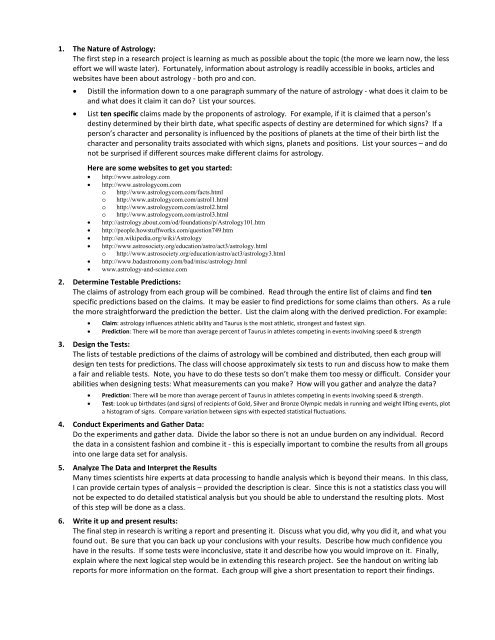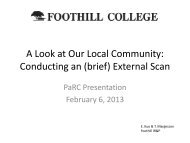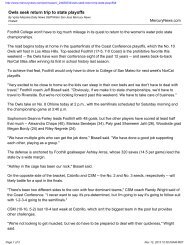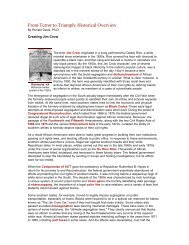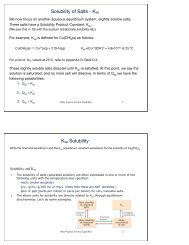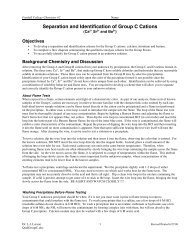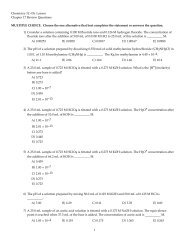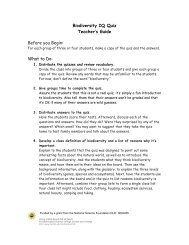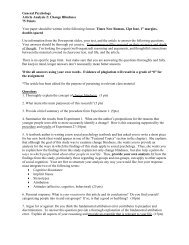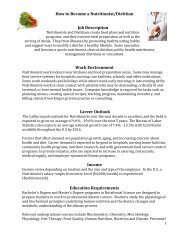USING THE SCIENTIFIC METHOD ON ASTROLOGY
USING THE SCIENTIFIC METHOD ON ASTROLOGY
USING THE SCIENTIFIC METHOD ON ASTROLOGY
Create successful ePaper yourself
Turn your PDF publications into a flip-book with our unique Google optimized e-Paper software.
1. The Nature of Astrology:<br />
The first step in a research project is learning as much as possible about the topic (the more we learn now, the less<br />
effort we will waste later). Fortunately, information about astrology is readily accessible in books, articles and<br />
websites have been about astrology ‐ both pro and con.<br />
• Distill the information down to a one paragraph summary of the nature of astrology ‐ what does it claim to be<br />
and what does it claim it can do? List your sources.<br />
• List ten specific claims made by the proponents of astrology. For example, if it is claimed that a person’s<br />
destiny determined by their birth date, what specific aspects of destiny are determined for which signs? If a<br />
person’s character and personality is influenced by the positions of planets at the time of their birth list the<br />
character and personality traits associated with which signs, planets and positions. List your sources – and do<br />
not be surprised if different sources make different claims for astrology.<br />
Here are some websites to get you started:<br />
• http://www.astrology.com<br />
• http://www.astrologycom.com<br />
o http://www.astrologycom.com/facts.html<br />
o http://www.astrologycom.com/astrol1.html<br />
o http://www.astrologycom.com/astrol2.html<br />
o http://www.astrologycom.com/astrol3.html<br />
• http://astrology.about.com/od/foundations/p/Astrology101.htm<br />
• http://people.howstuffworks.com/question749.htm<br />
• http://en.wikipedia.org/wiki/Astrology<br />
• http://www.astrosociety.org/education/astro/act3/astrology.html<br />
o http://www.astrosociety.org/education/astro/act3/astrology3.html<br />
• http://www.badastronomy.com/bad/misc/astrology.html<br />
• www.astrology-and-science.com<br />
2. Determine Testable Predictions:<br />
The claims of astrology from each group will be combined. Read through the entire list of claims and find ten<br />
specific predictions based on the claims. It may be easier to find predictions for some claims than others. As a rule<br />
the more straightforward the prediction the better. List the claim along with the derived prediction. For example:<br />
• Claim: astrology influences athletic ability and Taurus is the most athletic, strongest and fastest sign.<br />
• Prediction: There will be more than average percent of Taurus in athletes competing in events involving speed & strength<br />
3. Design the Tests:<br />
The lists of testable predictions of the claims of astrology will be combined and distributed, then each group will<br />
design ten tests for predictions. The class will choose approximately six tests to run and discuss how to make them<br />
a fair and reliable tests. Note, you have to do these tests so don’t make them too messy or difficult. Consider your<br />
abilities when designing tests: What measurements can you make? How will you gather and analyze the data?<br />
• Prediction: There will be more than average percent of Taurus in athletes competing in events involving speed & strength.<br />
• Test: Look up birthdates (and signs) of recipients of Gold, Silver and Bronze Olympic medals in running and weight lifting events, plot<br />
a histogram of signs. Compare variation between signs with expected statistical fluctuations.<br />
4. Conduct Experiments and Gather Data:<br />
Do the experiments and gather data. Divide the labor so there is not an undue burden on any individual. Record<br />
the data in a consistent fashion and combine it ‐ this is especially important to combine the results from all groups<br />
into one large data set for analysis.<br />
5. Analyze The Data and Interpret the Results<br />
Many times scientists hire experts at data processing to handle analysis which is beyond their means. In this class,<br />
I can provide certain types of analysis – provided the description is clear. Since this is not a statistics class you will<br />
not be expected to do detailed statistical analysis but you should be able to understand the resulting plots. Most<br />
of this step will be done as a class.<br />
6. Write it up and present results:<br />
The final step in research is writing a report and presenting it. Discuss what you did, why you did it, and what you<br />
found out. Be sure that you can back up your conclusions with your results. Describe how much confidence you<br />
have in the results. If some tests were inconclusive, state it and describe how you would improve on it. Finally,<br />
explain where the next logical step would be in extending this research project. See the handout on writing lab<br />
reports for more information on the format. Each group will give a short presentation to report their findings.


